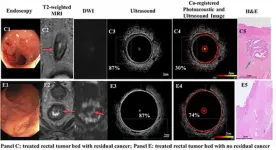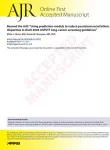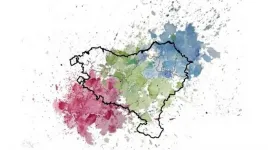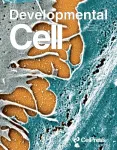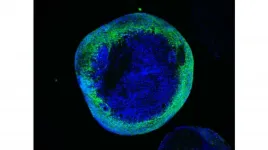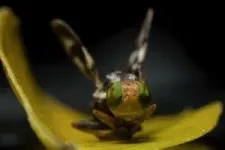(Press-News.org) Rectal cancer, along with colon cancer, is the third-most common type of cancer in the United States, and treatment and surgery greatly affect the quality of life of patients. A multi-disciplinary team at Washington University in St. Louis has developed and tested an innovative imaging technique that is able to differentiate between rectal tissues with residual cancers and those without tumors after chemotherapy and radiation, which could one day help to avoid unnecessary surgeries in some patients who have achieved complete tumor destruction after chemoradiation.
Quing Zhu, PhD, professor of biomedical engineering at the McKelvey School of Engineering, and members of her lab developed a system using a new imaging technique -- acoustic resolution photoacoustic microscopy co-registered with ultrasound (AR-PAM/US) and paired with a "deep learning" artificial intelligence neural network. This technique was better able to determine the presence of residual tumors in treated rectal tumor bed tissues than other types of imaging, such as MRI, which is often unable to discern residual cancer from scar tissue. Results of the research -- the first feasibility study using AR-PAM imaging in patients with rectal cancer previously treated with radiation and chemotherapy -- are published in the journal Radiology March 23.
"Our PAM/US system paired with the deep learning neural network has great potential to better identify patients suitable for nonoperative management and improve patient quality of life," Zhu said. "If we can tell after radiation and chemotherapy which patients may have a good response with no residual tumors, the patient may be able to avoid surgery."
Zhu, also professor of radiology at the School of Medicine, was joined on the paper by doctoral students Xiandong Leng, co-first author with Shihab Uddin, PhD, who earned a doctorate in biomedical engineering from McKelvey Engineering in 2020, and Hongbo Luo; and Sitai Kou.
They conducted a yearlong prospective study of patients with rectal cancer treated at Barnes-Jewish Hospital in St. Louis by School of Medicine clinicians: Matthew Mutch, MD, the Solon and Bettie Gershman Chair in Colon and Rectal Surgery, chief of the Section of Colon and Rectal Surgery and professor of surgery; and William Chapman Jr., MD, a resident physician in surgery. Zhu said others who contributed significantly to the study were: Steven R. Hunt, MD, associate professor of surgery; Anup Shetty, MD, assistant professor of radiology; Deyali Chatterjee, MD, assistant professor of pathology and immunology; and Michelle Cusumano, study coordinator in the Section of Colon and Rectal Surgery.
Chapman said the team spent more than three years investigating this technology in surgically removed colon and rectum specimens with promising results before developing the prototype for patient studies.
"We hope that improved imaging provided by AR/PAM will significantly improve our ability to discriminate between patients with residual tumors and those who have been completely cured without surgery," he said. "By both avoiding morbid, unneeded surgery and reducing the burden of surveillance testing, photoacoustic imaging could be a leap forward in the current management of locally invasive rectal cancer."
In the study, after completing chemotherapy and radiation, patients underwent PAM/US imaging with a handheld endorectal laser probe developed in Zhu's lab. The probe has a rotating head that allows for a 360-degree image of the rectum, the last 6 inches of the colon. The end of the probe, which takes one image per second, is covered by a small latex balloon inflated with water that allows transmission of the ultrasound and photoacoustic waves to the rectal wall. These waves highlight changes in the vasculature in the tissue and as well as new tumor growth. The imaging procedure added about 20 minutes of time that patients were under anesthesia.
Leng, who has been working on this project since 2017, was instrumental in system and software development, Zhu said. He designed and built the AR/PAM endoscope -- the first of its kind -- and programmed the system to acquire data and process and display images in real time.
"From the very preliminary ex vivo data, my setup clearly disclosed multi-layer structure from ultrasound image and rich blood vessels in the submucosa of normal colorectal tissue," Leng said. "In contrast to normal tissue, malignant tumor bed shows a lack of multilayer structure and blood vessels. This important finding may reveal an important feature accessing patients' treatment response to chemotherapy and radiation therapy."
In the first phase of the study, the team used data from surgically removed tissue specimens from more than 2,000 images from 22 patients to train the neural network, an artificial intelligence-based set of algorithms that operates similar to the human brain, to recognize normal and cancerous colorectal tissue. In the second phase, they used images from the living tissue from 10 patients who had previously undergone chemotherapy and radiation. Several hundred images from five of those patients were used to fine-tune the neural network, and hundreds of images from five patents were withheld for testing.
The deep-learning PAM model, designed and developed by Uddin, correctly predicted the cancerous status of all five of the patients who had undergone imaging, while the MRI images misclassified three out of five patients, and the ultrasound-only deep-learning model incorrectly declared three patients as cancer free.
Mutch said the team is very optimistic about the results.
"This is spectacular news, and it moves us closer in the transition from concept to clinically useful technology," he said. "The hope is that it will allow us to differentiate patients who had a complete response to chemotherapy and radiation from those patients with residual tumor. This will help better determine which patients can be managed nonoperatively versus those who truly need an operation."
Going forward, the team plans to conduct a clinical study to confirm these initial results in a large group of rectal cancer patients who have completed chemotherapy and radiation and will undergo surgery or follow patients after treatment.
INFORMATION:
Leng X, Shihab Uddin K M, Chapman Jr. W, Luo H, Kou S, Amidi E, Yang G, Chatterjee D, Shetty A, Hunt S, Mutch M, Zhu Q. Assessing rectal cancer treatment response using co-registered endorectal photoacoustic and ultrasound imaging. Radiology, March 23, 2021.
https://doi.org/10.1148/radiol.2021202208
Funding for this research was provided by pre-R01 funding from the Siteman Cancer Center and the Foundation for Barnes-Jewish Hospital; and the National Cancer Institute R01CA237664
The Institute for Quality and Efficiency in Health Care (IQWiG) revised its methods paper and published the German original version "Allgemeine Methoden 6.0" (General Methods 6.0) on http://www.iqwig.de in November 2020. This document is the basis for the scientific work of the Institute and its external experts as well as for the collaboration with its contracting agencies, the Federal Joint Committee (G-BA) and Federal Ministry of Health (BMG). The English translation is now available on http://www.iqwig.de/en/about-us/methods/methods-paper/.
New features include statements on the investigation of the relationship between volume of services and quality, a section on different treatment periods in studies, and a more concrete approach to the assessment of clinical relevance.
In ...
Scientists have developed a method to use lasers to control the movement of nanodiamonds with fluorescent centers.
Scientists have long been working on improving their ability to use lasers to move small objects without actually touching them. This method of 'optical trapping and manipulation' is already utilized in optics, biological sciences and chemistry. But objects become much more difficult to control once they grow to nanoscale size.
Now, a team of scientists including Hokkaido University's Keiji Sasaki and Osaka Prefecture University ...
Leesburg, VA, March 26, 2021--According to ARRS' American Journal of Roentgenology (AJR), updated United States Preventive Services Task Force (USPSTF) lung cancer screening (LCS) guidelines based solely on age, pack-years, and quit-years perpetuate eligibility disparities among racial and ethnic minorities, although incorporating certain risk prediction models may help reduce such inequalities.
By pulling data from the 2015 National Health Interview Survey (NHIS), Journal of the National Cancer Institute researchers (Landy et al.) were able to "estimate the effects of USPSTF-2020 guidelines on disparities in LCS eligibility for the non-institutionalized civilian US population," wrote Massachusetts ...
The Basques are a unique population in Western Europe; their language is not related to any Indo-European language. Furthermore, genetically speaking, they have been considered to have distinct features. However, until now there was no conclusive study to explain the origin of their singularity.
Now, an international research team led by UPF has confirmed that the Basques' genetic uniqueness is the result of genetic continuity since the Iron Age, characterized by periods of isolation and scarce gene flow, and not its external origin in respect of other Iberian populations.
The study, led by David Comas, principal investigator at UPF and at the Institute of Evolutionary Biology (IBE: CSIC-UPF), has involved ...
Atomically dispersed catalysts have received extensive research attention, because they exhibit excellent activity and unique selectivity for many important catalytic reactions. The atomically dispersed nature of these metal catalysts confers their unique electronic structures as well as designated coordination-unsaturated environments for the optimized adsorption/activation of the reactants. One grand challenge faced by these atomically dispersed catalysts is that the supported isolated metal \atoms are usually thermally unstable and tend to aggregate into large clusters/particles at evaluated reaction temperatures. As a result, most reported atomically dispersed catalysts have an extremely low metal loading below ...
Every year, millions of people around the world are displaced from their homes due to severe weather caused by climate change. According to the International Red Cross and Red Crescent Movement, 10.3 million people were displaced as a result of climate-?related events in the last six months alone - four times the number displaced by war and conflict in the same period. One of the main causes of displacement is flooding. A recent example is the situation in eastern Australia, where tens of thousands of people are having to flee their homes to seek safety from this hundred-?year flood.
An international research team led by the Weather ...
The skin is the largest organ in the human body, and its outermost part, called the epidermis, is replenished every three weeks. The cells fueling this renewal of the epidermal stem cells, found in specialized areas or niche, within a region of the hair follicle (or root) is known as the 'bulge compartment'. The bulge compartment resident stem cells are multipotent meaning that they can contribute to the repair of skin when it's injured, and also regenerate the hair follicles during normal development. While several groups have focused attention on the stem cells themselves, less is known about niche or extrinsic factors that influence the state of these stem cells.
In the recent paper published in the Developmental Cell, ...
Leigh syndrome is the most severe mitochondrial disease in children. It causes severe muscle weakness, movement defects, and intellectual disabilities. It usually leads to death within the first years of life. No causative treatment is currently available. One of the genes frequently mutated in patients is SURF1, which encodes for a protein involved in the process of energy generation in the cells. Animal models did not recapitulate the defects seen in the patients carrying mutations in SURF1. Therefore, the scientists did not have the tool to start understanding the disease mechanisms and to identify possible targets for treatment. They report about the first ...
Apple flies have fascinated scientists right from the mid-19th century, as they are a captivating example of speciation, the beginning of a new species. Correspondence between Charles Darwin and Benjamin Walsh, who observed the apple flies and hawthorn flies in North America, began the rich history of this scientific question in evolutionary biology. When settlers in North America introduced apple trees to the region, what happened within the hawthorn flies to make them shift to this new host plant in the last 300 years?
Continuing the 160-year-old inquiry into the origins of the apple fly, a team of scientists from around the world has just published their research in the Proceedings of the Royal Society B. The researchers span three continents, from the National Centre for Biological ...
Hematopoietic stem/progenitor cells (HSPCs) include hematopoietic stem cells and several lineage-biased hematopoietic progenitor cells, which can provide all blood cell types in an adult organism. Among them, hematopoietic stem cells have the ability of self-renewal and multi-lineage differentiation, and can rapidly respond under acute hematopoietic conditions. Meanwhile, the hematopoietic progenitor cells can maintain the supply of blood cells in homeostatic hematopoiesis. In a word, HSPCs are the core of the blood system, once their homeostasis is destroyed, it will lead to serious blood diseases and even death. Therefore, the researches associated with the HSPCs can provide a strong support for relevant ...
